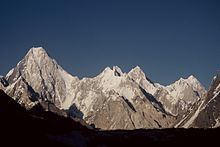Highest point Gasherbrum I | ||
 | ||
Mountains Gasherbrum I, Gasherbrum V Similar Gasherbrum II, Gasherbrum I, Broad Peak, Gasherbrum IV, K2 | ||
K2 and gasherbrum north face in china shaksgam valley to gasherbrum north base camp
Gasherbrum is a remote group of peaks located at the northeastern end of the Baltoro Glacier in the Karakoram range of the Himalaya on the border of the Chinese-administered Shaksgam Valley and the Gilgit-Baltistan territory of Pakistan. The massif contains three of the world's 8,000 metre peaks (if Broad Peak is included). Although the word "Gasherbrum" is often claimed to mean "Shining Wall", presumably a reference to the highly visible face of Gasherbrum IV, it comes from "rgasha" (beautiful) + "brum" (mountain) in Balti, hence it actually means "beautiful mountain".
Contents
- K2 and gasherbrum north face in china shaksgam valley to gasherbrum north base camp
- Map of Gasherbrum
- K2 and gasherbrum north face in china gasherbrum north base camp
- History of conquest
- References
Map of Gasherbrum
In 1856, Thomas George Montgomerie, a British Royal Engineers lieutenant and a member of the Great Trigonometric Survey of India, sighted a group of high peaks in the Karakoram from more than 200 km away. He named five of these peaks K1, K2, K3, K4 and K5, where the "K" denotes Karakoram. Today, K1 is known as Masherbrum, K3 as Broad Peak, K4 as Gasherbrum II and K5 as Gasherbrum I. Only K2, the second highest mountain in the world, has retained Montgomerie's name.
K2 and gasherbrum north face in china gasherbrum north base camp
History of conquest
On March 9, 2012 two Polish mountaineers made the first winter ascent of Gasherbrum I. The climbers – Adam Bielecki (aged 28) and Janusz Gołąb (aged 43) – made the ascent without supplementary oxygen.
